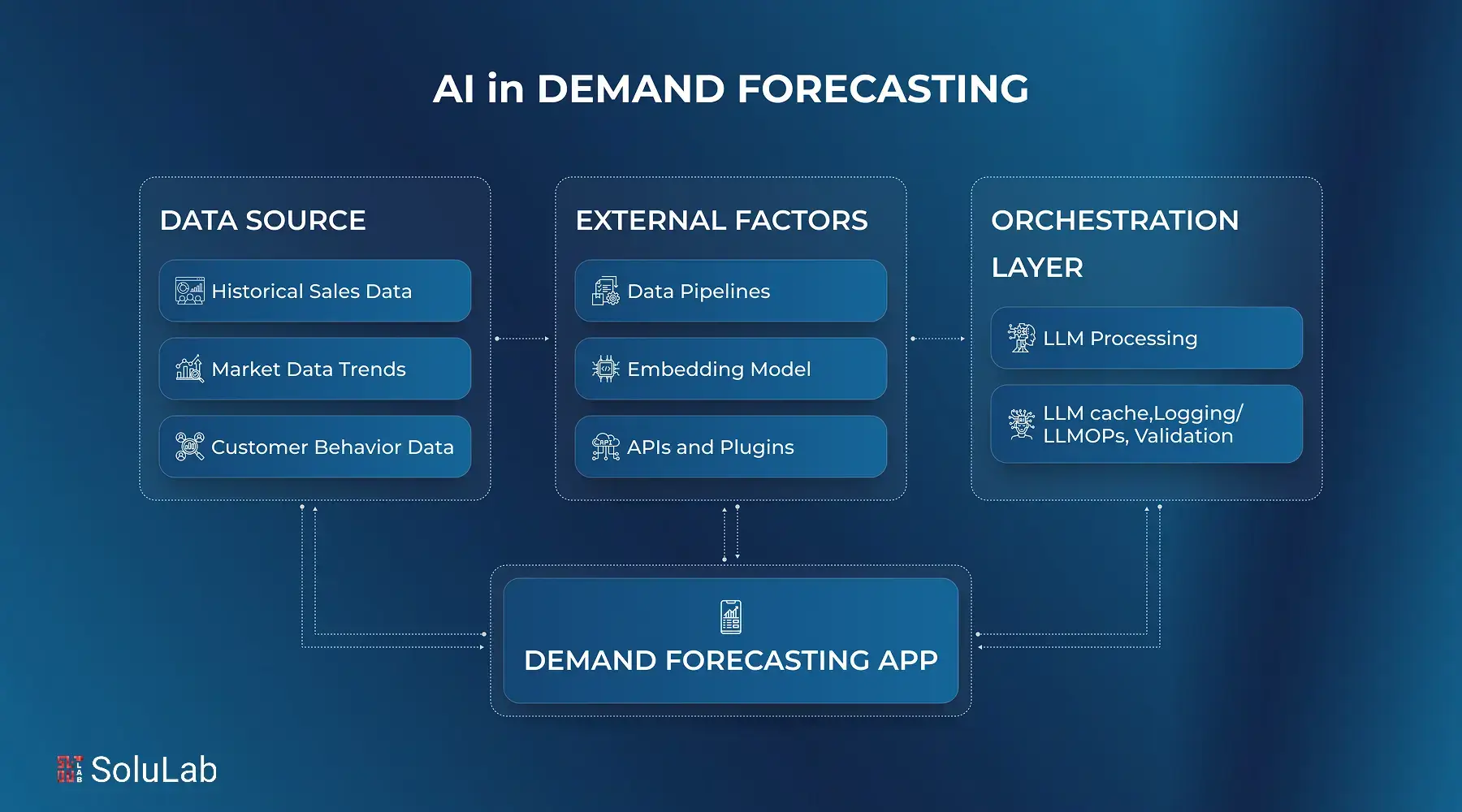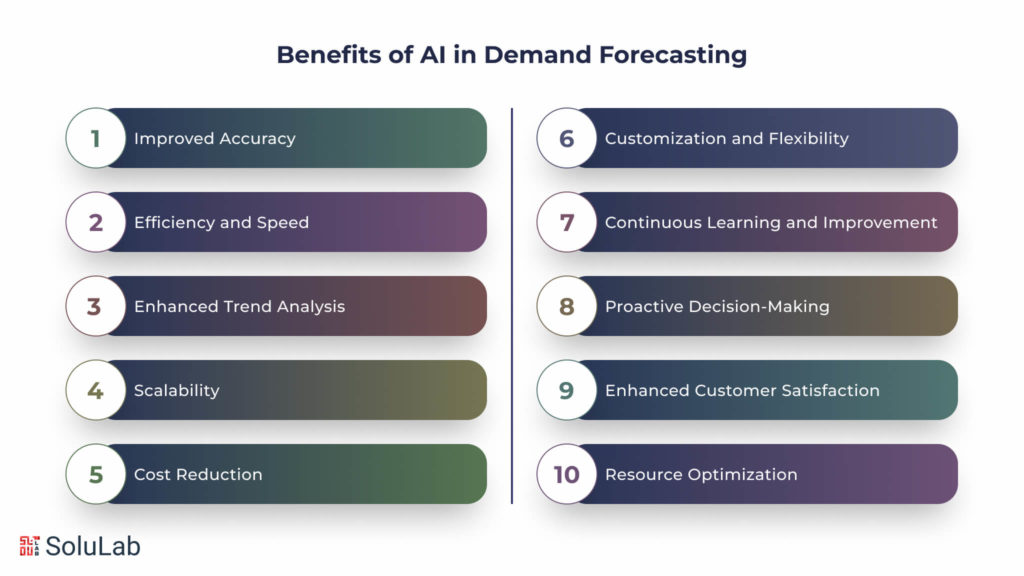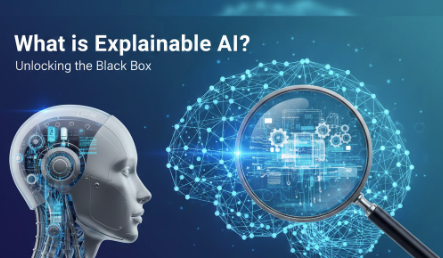
Still relying on spreadsheets and historical sales data for demand planning?
If yes, you’re not alone! But you might be falling behind because of that outdated method.
Traditional demand forecasting methods often fall short in today’s fast-paced and unpredictable market. When it comes to making important decisions like how much inventory to keep on hand or when to bring in new items, retailers earlier relied on their instincts. It was not very accurate or precise, but it did the job. Even minor forecasting errors can cause major ripple effects across the supply chain.
Needless to say, market conditions are changing faster than ever. Consumer preferences shift overnight, supply chain disruptions are more common, and competition is fierce. Thus, businesses need smarter tools to adapt in real-time and deliver accurate predictions. Artificial Intelligence is here to solve all of your what-if questions on forecasting.
As per McKinsey, AI-driven forecasting in supply chain management can cut errors by 20–50%, which can result in a 65% decrease in lost sales and product unavailability.
That is why the leading brands of today are opting to invest in AI for demand forecasting. Let’s delve deeper to understand the intent in detail!
What is AI-Powered Demand Forecasting?
While traditional forecasting strategies, sometimes known as “demand-driven” procedures, have historically used order data to estimate future inventory demands, these techniques often fail in today’s chaotic market. This results in either overstocking when demand suddenly drops or understocking when demand unexpectedly rises. These differences put strain on available resources and could lead to a company’s downfall.
AI for demand forecasting is not just a technical breakthrough; it is a conceptual shift. Demand forecasting based on AI is the future and the gold standard for inventory management. The innovative technique of AI-powered demand forecasting combines strategy and technology to enhance logistical operations. It enhances and simplifies the forecasting process. Demand forecasting with AI ML offers dynamic, real-time insights that surpass those of conventional models like ARIMA (Auto Regressive Integrated Moving Average) and exponential smoothing methods, which solely use historical data.
Steps to Implement AI for Demand Forecasting in Your Business
AI for demand forecasting works by using advanced algorithms and machine learning to analyze large volumes of data, recognize patterns, and make accurate predictions about future demand. Unlike traditional methods that rely mainly on past sales data and fixed models, AI continuously learns and adapts based on new inputs, helping businesses respond faster and more precisely to changing market conditions.
Let’s break it down step by step:
Step 1. Data Collection and Integration
The first step in AI forecasting is gathering and integrating data from multiple sources, including:
- Historical sales records
- Marketing campaigns
- Website or app traffic
- Inventory and supply chain systems
- External factors like weather, holidays, economic trends, and even social media activity
Step 2. Data Cleaning and Preparation
AI models need clean, accurate, and well-organized data. During this stage, the system:
- Removes duplicates or errors
- Fills in missing values
- Normalizes data for consistency
- Organizes data into formats suitable for analysis
This preprocessing stage ensures better model performance and fewer forecasting errors.
Step 3. Pattern Detection and Analysis
Once the data is ready, AI uses machine learning (ML) and deep learning techniques to:
- Identify trends like seasonal demand spikes
- Recognize patterns like weekend vs. weekday buying behavior
- Detect anomalies like sudden drops or spikes in demand
Step 4. Forecast Generation
The core AI model then produces demand forecasts by:
- Simulating future scenarios
- Adjusting predictions based on real-time data inputs
- Providing different forecast levels (product-level, store-level, regional-level)
Some tools use neural networks and time series forecasting models like LSTM (Long Short-Term Memory) or Prophet, which are particularly good at learning from complex and non-linear time-based data.
Step 5. Continuous Learning and Model Improvement
Unlike static models, AI systems constantly learn and improve over time. As more data becomes available, the model adjusts:
- Predictions become more accurate
- Forecasting adapts to new customer behaviors
This way, the system gets better at handling unexpected events like supply chain disruptions or demand surges.
Step 6. Actionable Insights and Automation
Finally, AI forecasting tools present results in dashboards or reports, often with prescriptive insights like:
“Increase inventory for Product X in Region Y next month.”
“Delayed reorder of Product Z due to declining demand.”
“Prepare for a 20% spike in orders during the holiday season.”
Hence, AI for forecasting works by combining big data, machine learning, and real-time analytics to create dynamic, accurate, and scalable demand predictions. This empowers businesses to make smarter decisions, reduce waste, and meet customer needs more effectively.
Why Leading Brands Are Switching to AI for Demand Forecasting?

Demand forecasting machine learning revolutionizes the way businesses predict future market trends, offering several key benefits across various sectors:
1. Improved Accuracy: Forecasting artificial intelligence significantly enhances prediction accuracy by analyzing large datasets and identifying patterns that traditional methods might miss. This leads to more reliable forecasts and better decision-making.
2. Efficiency and Speed: Leveraging demand AI streamlines the forecasting process, reducing the time and effort required. AI systems can quickly process vast amounts of data, providing faster insights and allowing businesses to respond promptly to market changes.
3. Enhanced Trend Analysis: AI in trend analysis offers deeper insights into market behaviors, identifying emerging trends and shifts more accurately. This is particularly beneficial for industries like fashion, technology, and consumer goods.
4. Scalability: Artificial intelligence for forecasting is highly scalable, making it suitable for both large enterprises and AI for startups. Startups can leverage AI to gain insights into market demands, optimize operations, and compete with established players.
5. Cost Reduction: Implementing demand forecasting machine learning reduces operational costs by minimizing overproduction, lowering inventory costs, and reducing the need for emergency procurement.
6. Customization and Flexibility: AI systems can be tailored to specific business needs, providing customized solutions that traditional forecasting methods cannot offer.
7. Continuous Learning and Improvement: AI models continuously learn and adapt from new data and user feedback, ensuring ongoing improvement in forecast accuracy and relevance.
8. Proactive Decision-Making: By leveraging demand forecasting machine learning, businesses can make proactive decisions based on predictive insights, allowing them to anticipate market needs and adjust strategies accordingly. This proactive approach helps in seizing opportunities and mitigating risks.
9. Enhanced Customer Satisfaction: Demand AI enables businesses to better match supply with customer demand, leading to fewer stockouts and overstock situations. This results in improved customer satisfaction and loyalty.
10. Resource Optimization: Artificial intelligence for forecasting helps businesses optimize resource allocation by predicting demand more accurately. This leads to better utilization of workforce, materials, and financial resources.
Top Use Cases of AI in Demand Forecasting
AI demand forecasting offers numerous practical applications across various industries. Here are some notable AI use cases:
- AI in Manufacturing: AI demand forecasting is transforming the manufacturing industry by optimizing inventory management and supply chain operations. With accurate demand predictions, manufacturers can maintain lean inventories, minimizing both overstock and stockouts. AI in manufacturing extends to the supply chain, where AI analyzes data from suppliers, production lines, and distribution networks to ensure timely procurement and efficient distribution. Predictive maintenance also benefits from AI, as it forecasts equipment failures based on demand patterns and operational data, reducing downtime and maintenance costs.
Read Blog: A Guide to AI in Product Development
- AI in Finance: Financial institutions leverage AI for market forecasting, credit scoring, risk assessment, and fraud detection. AI can predict market trends, stock prices, and economic indicators, aiding in investment strategies and risk management. By analyzing historical data and economic trends, AI in finance enhances credit scoring and risk assessment processes, allowing banks to make informed lending decisions. Additionally, AI improves fraud detection by identifying patterns and anomalies in transaction data, enhancing security and trust within financial systems.
- AI in Healthcare: In healthcare, AI demand forecasting helps hospitals and clinics predict patient inflow, ensuring optimal staffing, resource allocation, and inventory management for medical supplies. AI also predicts potential disease outbreaks by analyzing health data, enabling proactive public health responses and resource planning. Furthermore, AI in healthcare aids in developing personalized treatment plans by predicting patient responses to treatments based on historical data, improving the effectiveness of healthcare delivery.
- AI in Retail: Retailers use AI to forecast consumer demand, enabling better stock management, promotional planning, and pricing strategies. AI analyzes historical sales data, seasonal trends, and consumer behavior to predict future sales, helping retailers optimize their inventory and reduce the risk of overstock or stockouts. This results in improved customer satisfaction and increased sales efficiency.
- AI in Logistics: Logistics companies utilize AI demand forecasting to optimize route planning, fleet management, and delivery schedules. By predicting shipment volumes and delivery times, AI helps logistics providers allocate resources more effectively, reducing costs and improving service levels. AI can also forecast demand for transportation services, enabling better planning and utilization of assets.
- AI in Energy: The energy sector benefits from AI demand forecasting by predicting consumption patterns and optimizing energy production and distribution. AI models analyze historical consumption data, weather patterns, and economic indicators to forecast energy demand, helping utilities manage supply more efficiently and reduce waste. This leads to cost savings and improved sustainability in energy management.
- AI in Telecommunications: Telecommunications companies use AI to forecast demand for services and network capacity. By predicting data usage trends and customer behavior, AI helps telecoms optimize network performance, plan infrastructure investments, and enhance customer experience. AI-driven demand forecasting also aids in managing inventory for devices and equipment.
- AI in Agriculture: AI demand forecasting supports farmers and agribusinesses by predicting crop yields, market demand for produce, and optimal planting and harvesting times. By analyzing weather patterns, soil conditions, and historical crop data, AI helps farmers make informed decisions, improving productivity and profitability. AI can also forecast demand for agricultural inputs like seeds, fertilizers, and equipment.
- AI in Tourism and Hospitality: The tourism and hospitality industry uses AI to predict traveler demand, enabling better resource allocation, pricing strategies, and marketing efforts. AI analyzes booking patterns, seasonal trends, and economic factors to forecast occupancy rates and visitor numbers. This helps hotels, airlines, and travel agencies optimize their operations and enhance customer experience.
These diverse AI agent use cases to illustrate the broad applicability of AI demand forecasting across various sectors. Whether it’s AI in manufacturing, AI in finance, AI in healthcare, AI in retail, AI in logistics, AI in energy, AI in telecommunications, AI in agriculture, or AI in tourism and hospitality, the ability to accurately predict demand enables businesses to optimize operations, enhance customer satisfaction, and maintain a competitive edge in dynamic markets.
AI in Demand Forecasting: What’s Coming in the Next 5 Years?
Over the next five years, we can expect AI to become smarter, faster, and more deeply integrated into business operations. Here’s a look at the key trends and innovations that will shape the future of AI-powered demand forecasting:
1. Real-Time Forecasting Will Become the Norm
Traditional forecasting models often rely on weekly or monthly updates. In contrast, future AI systems will offer real-time demand forecasting, constantly adjusting predictions based on live data such as website activity, news events, weather patterns, or supply chain disruptions. Businesses will be able to respond to market changes almost instantly, improving agility and reducing losses.
2. IoT Integration for Smarter Data
The combination of AI and Internet of Things (IoT) devices will create powerful forecasting ecosystems. Smart shelves, RFID tags, and connected warehouse sensors will feed real-time data into AI models, allowing them to track inventory movement, sales velocity, and even customer foot traffic with pinpoint accuracy.
3. Hyper-Personalized Forecasting
As AI gets more advanced, demand forecasting will shift from broad market trends to customer-specific predictions. Businesses will forecast demand not just for product categories or regions, but for individual customer segments or even single users.
4. Autonomous Supply Chains
In the next five years, AI won’t just predict demand, it will take action based on those predictions. We can expect the rise of autonomous supply chains, where AI systems automatically reorder stock, reroute shipments, or trigger production changes without human intervention.
All in all, the next five years will redefine how businesses understand and respond to customer demand. AI will not just support forecasting, it will upgrade it, bringing speed, accuracy, and automation to a whole new level.
Conclusion
AI-powered demand forecasting has the potential to transform how companies anticipate and react to market changes. By using sophisticated algorithms and real-time data integration, businesses can increase forecasting accuracy and efficiency.
SoluLab, a top AI development company, holds unmatchable expertise in AI and machine learning that ensures seamless integration with your existing systems and the development of robust, scalable models. We provide end-to-end solutions tailored to your specific needs, helping you overcome the hurdles and fully realize the benefits of AI demand forecasting.
Ready to transform your business with AI? Contact us today to hire AI developers and discuss your unique idea!
FAQs
1. How long does it take to implement AI demand forecasting?
It depends on your data readiness and business size. With the right tools and clean data, implementation can begin in a few weeks. However, for full-scale forecasting across multiple product lines, it may take a few months to fine-tune the system.
2. How does AI improve the accuracy of demand forecasts?
AI improves forecast accuracy by leveraging advanced algorithms that analyze large volumes of data more effectively than traditional methods. AI models can detect complex patterns and trends, incorporate real-time data, and adjust forecasts dynamically. This leads to more precise predictions, reducing the risk of overstocking or stockouts.
3. What types of AI algorithms are commonly used in demand forecasting?
Common AI algorithms used in demand forecasting include linear regression, decision trees, neural networks, and time series models such as ARIMA and LSTM. The choice of algorithm depends on the nature of the data and the specific forecasting needs of the business.
4. Is AI demand forecasting secure and trustworthy?
Mostly, the modern AI tools are built with strong data security features. Trustworthiness depends on the quality of the model, the data used, and continuous monitoring to ensure that predictions remain accurate and unbiased.
5. How can SoluLab assist with AI demand forecasting?
SoluLab specializes in AI development and can help businesses overcome challenges in implementing AI demand forecasting. We offer end-to-end solutions, including data preprocessing, model development, integration with existing systems, and continuous support. Our expertise ensures that your AI models are accurate, reliable, and tailored to your specific needs. Contact Us to learn more about how we can assist you.






